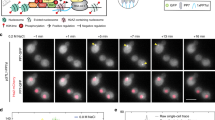Abstract
Many regulatory proteins undergo transient nuclear relocation under physical or chemical stress. This phenomenon is, however, difficult to assess due to the lack of sensitive and standardized biological assays. Here, we describe a new quantitative nuclear relocation assay (QNR), based on expression in yeasts of chimeric proteins in which an artificial transcription factor is fused to a target protein acting as driver for relocation. This assay combines the experimental versatility of yeast with quantitation of nuclear relocation at low levels of protein expression. We have assessed the nuclear relocation of yeast Yap1 and human p53, two transcription factors that relocate to the nucleus in response to oxidative-stress and DNA damage, respectively. We show that p53 efficiently drives the relocation of the chimeric reporter in response to irradiation and that this process requires the C-terminal nuclear export signal (NES). Cd2+ and Hg2+, two metal ions inducing DNA damage as well as conformational changes in p53, have opposite effects on p53 relocation in response to DNA damage. Whereas Hg2+ effects are synergistic to DNA damage, Cd2+ inhibits relocation and sequesters p53 into the cytoplasm. These results demonstrate the effectiveness of QNR to investigate the regulation of p53 shuttling in response to stress signals including suspected environmental carcinogens.
This is a preview of subscription content, access via your institution
Access options
Subscribe to this journal
Receive 50 print issues and online access
$259.00 per year
only $5.18 per issue
Buy this article
- Purchase on Springer Link
- Instant access to full article PDF
Prices may be subject to local taxes which are calculated during checkout






Similar content being viewed by others
References
Bischoff JR, Casso D and Beach D . (1992). Mol. Cell. Biol., 12, 1405–1411.
Candau R, Scolnick DM, Darpino P, Ying CY, Halazonetis TD and Berger SL . (1997). Oncogene, 15, 807–816.
Cyert MS . (2001). J. Biol. Chem., 276, 20805–20808.
Delaunay A, Isnard AD and Toledano MB . (2000). EMBO J., 19, 5157–5166.
Delaunay A, Pflieger D, Barrault MB, Vinh J and Toledano MB . (2002). Cell, 111, 471–481.
Fabbro M and Henderson BR . (2003). Exp. Cell Res., 282, 59–69.
Flaman JM, Frebourg T, Moreau V, Charbonnier F, Martin C, Chappuis P, Sappino AP, Limacher IM, Bron L and Benhattar J . (1995). Proc. Natl. Acad. Sci. USA, 92, 3963–3967.
Fritsche M, Haessler C and Brandner G . (1993). Oncogene, 8, 307–318.
Hood JK and Silver PA . (1999). Curr. Opin. Cell Biol., 11, 241–247.
Ishioka C, Frebourg T, Yan YX, Vidal M, Friend SH, Schmidt S and Iggo R . (1993). Nat. Genet., 5, 124–129.
Jimenez GS, Khan SH, Stommel JM and Wahl GM . (1999). Oncogene, 18, 7656–7665.
Kato S, Han SY, Liu W, Otsuka K, Shibata H, Kanamaru R and Ishioka C . (2003). Proc. Natl. Acad. Sci. USA, 100, 8424–8429. Epub 2003 Jun 25.
Kitagawa K and Abdulle R . (2002). Biotechniques, 33, 288–292.
Klibanov SA, O'Hagan HM and Ljungman M . (2001). J. Cell Sci., 114, 1867–1873.
Kuge S and Jones N . (1994). EMBO J., 13, 655–664.
Kuge S, Jones N and Nomoto A . (1997). EMBO J., 16, 1710–1720.
Kungolos A, Aoyama I and Muramoto S . (1999). Ecotoxicol. Environ. Saf., 43, 149–155.
Lee J, Godon C, Lagniel G, Spector D, Garin J, Labarre J and Toledano MB . (1999). J. Biol. Chem., 274, 16040–16046.
Meplan C, Mann K and Hainaut P . (1999). J. Biol. Chem., 274, 31663–316670.
Merwin JR, Mustacich DJ, Muller EG, Pearson GD and Merrill GF . (2002). Carcinogenesis, 23, 1609–1615.
O'Keefe K, Li H and Zhang Y . (2003). Mol. Cell. Biol., 23, 6396–6405.
Oldenburg KR, Vo KT, Michaelis S and Paddon C . (1997). Nucleic Acids Res., 25, 451–452.
Schnell N, Krems B and Entian KD . (1992). Curr. Genet., 21, 269–273.
Stommel JM, Marchenko ND, Jimenez GS, Moll UM, Hope TJ and Wahl GM . (1999). EMBO J., 18, 1660–1672.
Sutton DJ, Tchounwou PB, Ninashvili N and Shen E . (2002). Int. J. Mol. Sci., 3, 965–984.
Waalkes MP . (2003). Mutat. Res., 533, 107–120.
Wu A, Wemmie JA, Edgington NP, Goebl M, Guevara JL and Moye-Rowley WS . (1993). J. Biol. Chem., 268, 18850–18858.
Zhang Y and Xiong Y . (2001). Science, 292, 1910–1915.
Acknowledgements
We gratefully acknowledge Jean Armengaud and Elisabeth Darrouzet for critical reading of the manuscript, Jean Labarre and Michel Toledano for the gift of vectors, yeast strains and for helpful discussions. We also thank Yves Brignon, Claude Dubois, Thierry Jouve, and Pascale Richard for technical support. Work on yeast assays at IARC is supported by EC contract No 20053-2002-11 F1ED ISP FR.
Author information
Authors and Affiliations
Corresponding author
Rights and permissions
About this article
Cite this article
Godon, C., Coullet, S., Baus, B. et al. Quantitation of p53 nuclear relocation in response to stress using a yeast functional assay: effects of irradiation and modulation by heavy metal ions. Oncogene 24, 6459–6464 (2005). https://doi.org/10.1038/sj.onc.1208785
Received:
Revised:
Accepted:
Published:
Issue Date:
DOI: https://doi.org/10.1038/sj.onc.1208785
Keywords
This article is cited by
-
Radiation-induced bystander effects in the Atlantic salmon (salmo salar L.) following mixed exposure to copper and aluminum combined with low-dose gamma radiation
Radiation and Environmental Biophysics (2014)



